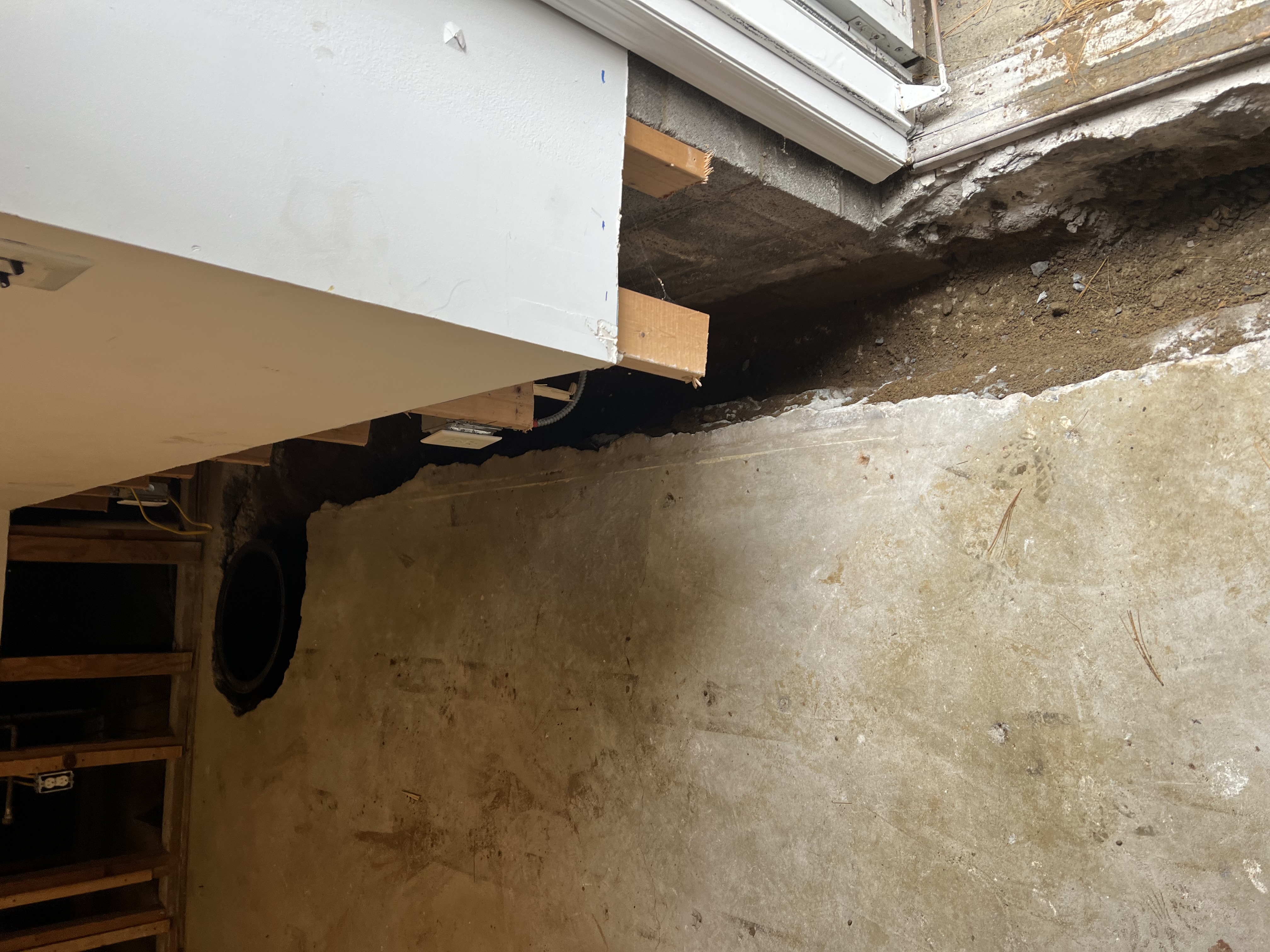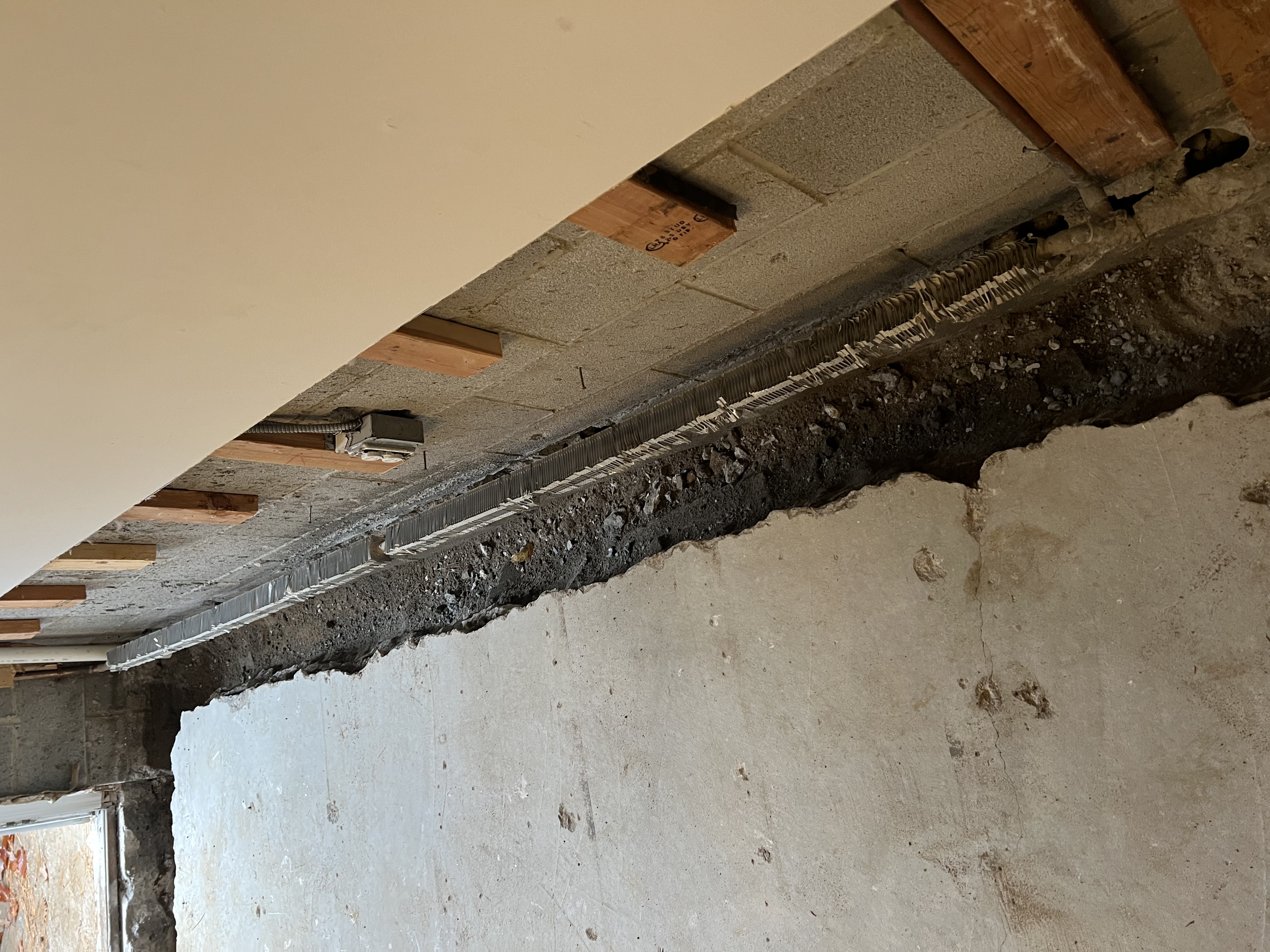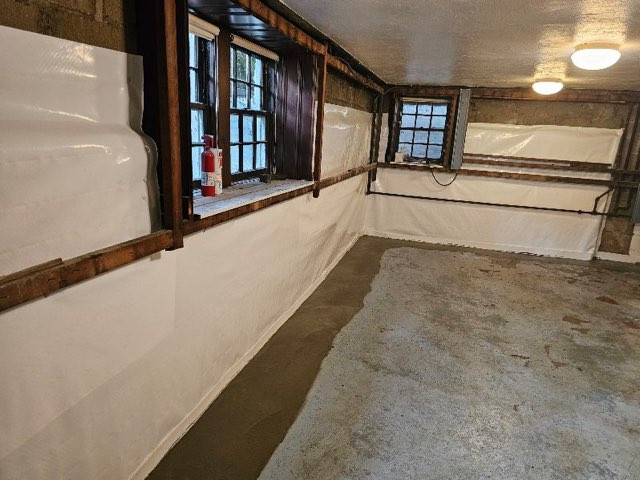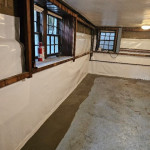As winter approaches, you must turn your attention to your home’s defenses, particularly your basement. Have you inspected for potential leaks or cracks that could let in moisture? Or checked your drainage system to ensure water is properly diverted away from your home’s foundation? Perhaps you’ve thought about the role a sump pump or a dehumidifier could play in keeping your basement dry? There’s plenty to discuss when it comes to effective basement waterproofing for winter, and the better prepared you are, the more peace of mind you’ll have when the cold weather hits.
Key Takeaways
- Regularly inspect basement for cracks and leaks, sealing them promptly to prevent moisture entry.
- Ensure effective drainage and moisture management by using dehumidifiers and maintaining proper water flow.
- Install and maintain a sump pump to remove excess water and reduce the risk of damage.
- Protect pipes from freezing with high R-value insulation materials like blanket-style insulation or pre-slit foam tubing.
- Consider hiring professional waterproofing services for complex issues, ensuring they have a proven track record and positive reviews.
Understanding Winter Basement Risks
In the heart of winter, your basement faces a unique set of challenges. Cold temperatures may cause your pipes to freeze, creating a mess that’s difficult to clean up, not to mention costly to repair.
Snow accumulation, particularly if it’s heavy, can also put significant pressure on the basement walls, leading to potential cracks and leaks.
You’ve probably heard of frozen pipes, but do you know why they’re such a big deal? When water freezes, it expands. If the water in your pipes freezes, it can cause the pipes to burst.
A burst pipe can lead to significant water damage in your basement, damaging your possessions and potentially leading to structural issues in your home.
Snow accumulation also poses a risk. As snow piles up against your home, it can put pressure on your basement walls. If the pressure becomes too great, it can lead to cracks or leaks in your basement walls.
Understanding these winter basement risks is the first step towards protecting your home. With this knowledge, you can start to take measures to prevent these issues before they happen, helping to keep your basement dry and your home safe.
Importance of Proper Drainage
 Without a doubt, proper drainage plays a pivotal role in maintaining a dry and safe basement. As winter comes around, you’ll need to be even more cautious about how water flow is handled in your home’s lower levels. Effective drainage systems can make all the difference, and here’s why.
Without a doubt, proper drainage plays a pivotal role in maintaining a dry and safe basement. As winter comes around, you’ll need to be even more cautious about how water flow is handled in your home’s lower levels. Effective drainage systems can make all the difference, and here’s why.
Firstly, consider the damage that stagnant water can cause. It’s not just about wet floors and walls, it’s about the long-term structural damage that can occur. Improper drainage can lead to foundation issues, which are costly and complex to fix.
Secondly, correct water flow prevents the growth of mold and mildew. These not only damage your property but can also pose health risks. A well-designed drainage system keeps water moving, not allowing it to sit and create a damp environment where these organisms can thrive.
Lastly, maintaining proper drainage is crucial for your home’s value. Any signs of water damage can drop your property’s worth significantly. So, it’s not just about comfort and safety, it’s about protecting your investment.
In a nutshell, an efficient drainage system is a homeowner’s best friend during the long, wet winter months. Don’t underestimate its importance.
Inspect for Cracks and Leaks
Building on the theme of protecting your basement from water damage, let’s now turn our attention to another important step: inspecting for cracks and leaks. This crucial task can’t be overlooked if you’re aiming for a dry, safe basement this winter.
Crack detection is your first line of defense. Small, almost invisible cracks might seem harmless, but they’re gateways for moisture. You’ve got to carefully scrutinize your basement walls and floor. Use a bright light to ensure you don’t miss anything.
Pay special attention to corners and joints, as these areas often hide cracks.
Next comes leak assessment. Leaks aren’t always as obvious as a puddle on the floor. Look out for discoloration or damp spots on walls and ceilings. Don’t forget to check hidden areas, such as behind appliances or stored items.
And remember, a musty smell is often a telltale sign of a hidden leak.
It’s important to understand that you’re not just looking for visible water. Even the slightest dampness can lead to serious issues like mold growth and structural damage.
Seal Your Basement Walls
Now let’s talk about how to seal your basement walls.
Firstly, we’ll look at how to choose the right sealant for your specific needs.
Then, we’ll go through the application process and how to maintain your sealed walls over time.
Choosing the Right Sealant
Dive headfirst into the task of selecting the right sealant to waterproof your basement walls. When it comes to sealant types, there’s a wide range to choose from, and each offers its own set of benefits.
Silicone sealants, for instance, are known for their superior adhesion and weather-resistant properties. They’re an excellent choice for areas with high moisture levels.
Acrylic sealants, on the other hand, are easy to apply and dry quickly, making them ideal for quick fixes.
But it’s not just about the type of sealant, it’s also about the application methods.
Spraying, for example, allows for a uniform distribution of the product and is perfect for large areas.
Brushing, however, gives you more control over where the product goes, making it great for small, detailed work.
Sealant Application Process
Having chosen the right sealant for your basement walls, it’s time to begin the application process. The sealant types you’ve picked, whether it’s a concrete sealer, silicate-based sealer, or waterproof paint, will determine the tools you need for application.
You need to prepare your walls before applying the sealant. Start by cleaning the surfaces with a wire brush to remove any dirt or loose particles. You’ll want your walls as smooth as possible for the sealant to adhere properly.
Next, gather your application tools. For a concrete sealer or silicate-based sealer, you’ll typically need a paint roller or a brush. If you’re using waterproof paint, a paint sprayer might be the better choice. Make sure to follow the manufacturer’s instructions on the sealant package for the best results.
Now, you’re ready to apply the sealant. Start from the bottom and work your way up, ensuring you cover all areas. Apply a second coat if recommended by the manufacturer.
Lastly, let it dry thoroughly.
Sealing your basement walls isn’t just about application; it’s about doing it right. So, take your time and do a thorough job. Your dry, warm basement will thank you for it.
Maintaining Sealed Walls
Even after you’ve successfully sealed your basement walls, maintenance is key to ensure their longevity.
Don’t overlook this important step; regular upkeep can prevent future moisture-related problems and maintain your wall integrity.
Inspect your walls regularly for signs of moisture. This could be in the form of damp spots, peeling paint, or mold growth.
If detected early, it’s easier to control moisture and prevent extensive damage to your wall seals.
Next, clean your walls periodically. Dirt and debris can trap moisture, leading to the breakdown of your sealant over time.
Use a mild detergent and a soft brush to gently scrub your walls, then let them dry thoroughly before reapplying a new layer of sealant if needed.
Make sure your basement’s ventilation is effective.
Good airflow helps in moisture control by reducing humidity levels.
Consider investing in a dehumidifier if your basement is particularly damp.
The Role of Sump Pumps
In the fight against basement moisture, your sump pump plays a crucial role. It’s your first line of defense, whisking away excess water before it can wreak havoc on your home.
But not all sump pumps are created equal. Understanding sump pump types is key to ensuring you’ve got the right tool for the job.
Submersible and pedestal are the two main types of sump pumps. Submersible pumps are installed in a pit and are designed to function underwater, while pedestal pumps sit above the water line. Your choice depends on your basement’s specific needs.
Of course, having the right sump pump is only half the battle. Regular sump pump maintenance is also crucial. You don’t want to discover that your pump isn’t working when you’re knee-deep in water.
Make a habit of checking your pump frequently. Listen for unusual noises, check for obvious signs of wear and tear, and test the pump by pouring a bucket of water into the pit. If it’s not working, don’t hesitate to call a professional.
Insulating Pipes and Tanks
Now, let’s turn our attention to insulating pipes and tanks.
It’s crucial to select the right insulation material to prevent any potential water damage.
We’ll also cover useful techniques for tank insulation to ensure your basement remains dry and secure.
Choosing Proper Insulation Material
When tackling basement waterproofing, one crucial step you mustn’t overlook is choosing the proper insulation material for your pipes and tanks. This choice isn’t just about keeping your basement dry; it’s about improving thermal performance and ensuring the longevity of your plumbing system.
Thermal performance is vital; you need insulation that can effectively reduce heat transfer. This means choosing materials that have high R-values. The higher the R-value, the better the material’s insulating properties. In cold weather, you’ll want your pipes and tanks to retain as much heat as possible to prevent freezing and subsequent damage.
Material durability should be another key factor in your decision. You’re looking for insulation that can withstand moisture, pests, and temperature changes without losing its effectiveness.
Options like fiberglass, foam, and rubber can offer good thermal performance and durability, but each has its pros and cons. Consider the specific needs of your basement and choose accordingly.
Tank Insulation Techniques
You might wonder how to go about insulating your tanks and pipes effectively. Well, don’t stress, it’s simpler than you think. Tank insulation is a crucial part of tank maintenance, especially during winter. By insulating your tanks and pipes, you offer them protection against freezing temperatures, ensuring they continue to function optimally.
There are several insulation techniques you can use. The blanket-style insulation is a popular choice. It’s easy to install and provides good coverage. Just wrap the insulation around the tank and secure it with tape.
For pipes, use pre-slit foam tubing. It’s designed to fit right over pipes, providing excellent insulation benefits.
Remember, insulation not only prevents freezing but also reduces heat loss. This means your heating system doesn’t have to work as hard, leading to lower energy costs.
So, while you’re keeping your tanks and pipes safe from the cold, you’re also saving money.
Proper tank maintenance is essential to ensure its longevity. By insulating your tanks and pipes, you’re giving them the best chance to survive the winter unscathed.
Use of Dehumidifiers
In the battle against basement dampness, a dehumidifier can be your secret weapon. This robust device aids in humidity control and moisture management, two crucial aspects of basement waterproofing. Dehumidifiers extract excess moisture from the air, preventing it from seeping into your walls and floor.
Operating a dehumidifier is pretty straightforward. You plug it in, adjust the humidistat to the desired humidity level, and let it do its job. For optimum performance, you’ll want to keep doors and windows closed.
Here’s a quick comparison table to help you decide on the best dehumidifier for your basement:
| Size | Coverage Area | Ideal For |
|---|---|---|
| Small | Up to 1,000 sq. ft. | Small basements or specific damp areas |
| Medium | 1,000 to 2,000 sq. ft. | Medium sized basements |
| Large | 2,000 to 3,000 sq. ft. | Large or very damp basements |
Regular Basement Maintenance
Regular maintenance of your basement is a crucial step towards keeping it dry and waterproof. It’s not just about fixing leaks when they occur; it’s about preventing them in the first place.
Regular checks and upkeep can save you a lot of hassle and expense down the line.
Basement ventilation is a key element of this maintenance. You should ensure that your basement has good air flow to prevent the buildup of humidity, which can lead to dampness and mold growth.
Invest in a good quality ventilation system and keep it clean and in good working order.
Humidity control is another vital aspect of basement maintenance. Too much humidity can damage your basement’s structural integrity and create a perfect environment for mold growth.
Consider using a dehumidifier to control the level of humidity in your basement. Regularly check and empty the dehumidifier to ensure it’s working effectively.
Hiring Professional Waterproofing Services
 Sometimes, despite your best efforts, professional intervention becomes necessary to ensure your basement remains dry and waterproof.
Sometimes, despite your best efforts, professional intervention becomes necessary to ensure your basement remains dry and waterproof.
When it comes to hiring professional waterproofing services, there are a few things you need to keep in mind.
- Experience: You’ll want to hire a team with a solid track record in basement waterproofing. This isn’t a job for amateurs, and you don’t want to risk further damage to your property.
- Cost Considerations: Be sure to get multiple quotes. While you shouldn’t necessarily go with the cheapest option, you don’t want to overpay either. Make sure the cost is justified by the quality of work.
- Service Warranties: A professional company should offer service warranties. This gives you some protection should any issues arise after the job is completed.
- References and Reviews: Always check references and reviews. A reputable company will have satisfied customers willing to vouch for their work.
Frequently Asked Questions
Can Basement Waterproofing Increase the Value of My Home?
Absolutely, basement waterproofing can increase your home’s value.
It’s a smart home improvement project that’s often overlooked. When you waterproof your basement, you’re preventing potential water damage and creating a healthier living environment.
These benefits appeal to buyers, positively impacting your home’s value assessment.
Plus, a waterproofed basement offers potential for additional living space.
How Often Should I Replace My Basements Waterproof Membrane?
You should replace your basement’s waterproof membrane when it shows signs of wear, which can be after several years.
Its lifespan usually depends on the materials used and the conditions it’s exposed to.
Look for cracks, peeling, or water seepage as these indicate replacement is needed.
Don’t wait till you’re knee-deep in water!
Staying proactive is key in maintaining your home’s value and ensuring a dry, safe basement.
So, don’t let winter leave you with a wet, damaged basement. Stay proactive with regular checks for cracks and leaks, and ensure your drainage system is spot on. Don’t forget, sump pumps and dehumidifiers play a big role in keeping your basement dry. Insulate your pipes and tanks to prevent freezing. Regular maintenance is key, but for complex issues, it’s worth hiring professional waterproofing services. Keep your basement dry and safe this winter!



